Welcome! 歡迎! 欢迎! 환영!
Takikawa Skypark Hubhouse
Takikawa Skypark Hubhouse, a JNTO Certified Tourist Information Center
In December 2017, the Takikawa Skypark Hubhouse was officially recognized under Category 2 of the Japan National Tourism Organization’s (JNTO) TIC (Tourist Information Center) certification program. The Takikawa Skypark provides information on tourist attractions within the city, region, and the rest of Hokkaido to international visitors, along with information essential for a pleasant trip such as weather and traffic reports and disaster prevention guidelines. Rest facilities are also available here.

Managing Association: Skysports Association of Takikawa(SATA)
Opening Hours:
- 9:00~17:00 (open from Apr through Nov)
- 9:00~16:00 (Dec – Mar) *Closed on Saturdays, Sundays, and public holidays Dec - Mar
Languages:
- English
- Chinese
- Korean *An audio translation machine will be used for translations into Korean and Chinese.
Further information: https://tic.jnto.go.jp/detail.php?id=3294
Public Toilet Information:

Sightseeing Information about Takikawa
What would you like to do in Takikawa? Eat delicious food? Shop? Play to your heart’s content under the broad skies? The tourist information staff are happy to give you recommendations that best match your interests!
Activities/Attractions
Gliders
The only place in Japan where you can experience flying the skies like a bird!
~Staff’s Comment~
Ask staff members for their top recommendation, and the answer would undoubtedly be riding in a glider. Exult in the magnificent sights of Hokkaido from a bird’s eye view. There will be an experienced pilot flying the glider, so it is completely safe!

The glider is a kind of aircraft. Just like an airplane, it has wings and a human pilot but flies independently without an engine (however, there are also gliders with engines which are called motor gliders). The glider flies by converting altitude to speed. At first, it is launched by an aircraft called a tug-plane. It is then released from the tow rope in the air to fly and glide. The glider then gradually descends but can stay in the air for prolonged periods by riding on rising air currents. If piloted well, a glider can sometimes stay in the air for over 5 to 6 hours.
Takikawa Skypark

The Takikawa Skypark, the first aviation park in Japan, is located along the Ishikari River and equipped with facilities for flight. Here, you can experience riding in the gliders. Come immerse yourself in the blue skies and gaze upon the broad expanse of land from the skies. An instructor will be piloting the glider so you can safely enjoy the scenery even if you are flying for the first time.
Address :139-4 Nakajima, Takikawa, Hokkaido 073-0035, JAPAN.
Phone No. 0125-24-3255
Experiential Programs
~Staff’s Comment~
At Fureai no Sato, there are many experiential programs for you to choose from.
Instructors will also be on hand, so fret not even if it is your first time!
Please reach out to us for more details.
Eat/Drink
~Staff’s Comment~
When it comes to food, our recommendation is none other than Genghis Khan (a grilled mutton dish). There are many types of Genghis Khan in Hokkaido but Takikawa is proud to be the birthplace of the marinated Genghis Khan. Let’s dig into soft and sumptuous meat!

■ Hotels and Sanraku Street Gourmet Map (English)
A gourmet map designed for those visiting Takikawa on business or leisure.
The restaurants listed are all within a walking distance from a hotel.
*You can view the brochure contents(14882KB) when you click the image .
There’s still more to explore!
Takikawa Tourism Association Homepage
Accommodations/ Hot Springs
~Staff’s Comment~
If you would like to recover from the fatigue of travel, head to any of the hotels, traditional Japanese inns, and cottages conveniently located near to the JR Takikawa Station. You can also unwind and relax in any of the hot springs in Takikawa.

■ Accommodations in Takikawa City:
http://www.kankou-takikawa.jp/wp-content/uploads/2016/01/51078a0a86e57412090e032a6732772b.pdf
Events
~Staff’s Comment~
Takikawa’s signature event is without question the Canola Flower (Nanohana) Festival. From mid-May to late-May, Takikawa is decked out in the color of the yellow canola flowers. Takikawa’s seasonal events are also rich in their own charms. Please do pay us a visit at least once!
Takikawa Canola Flowers

Since 1988, Takikawa’s production of canola flowers has rapidly increased, and it has now become the city with the largest production levels of canola flowers in Japan. Sometime between late-May and early-June, the yellow canola flowers spread brilliantly across the many fields in the city, a beautiful sight that attracts many foreign and domestic tourists to Takikawa. In 2015, the total area of the canola flower fields was no.1 in Japan, with the largest field of 10 hectares at Ebeotsu 19 cho-me.
About the Canola Flowers

There are 2 types of canola flowers cultivated in Takikawa. The first is the Kizaki no Natane (rapeseed, Brassica napus) which is mainly cultivated for oil that is sold throughout Japan. However, another variety of canola flower, the Haru no Kagayaki is also grown here for local consumption.
Canola Specialty Products

Using the oil of Takikawa’s canola flowers, a variety of products is created and sold for local consumption. In addition, the Yuki wari Nabana which goes well with many culinary dishes is sold for a limited time in early spring. Please click here to view our canola products.
*In particular, the Yuki wari Nabana grown in Takikawa is more nutritious, sweeter and softer than those grown elsewhere.
Summer Sky Festival
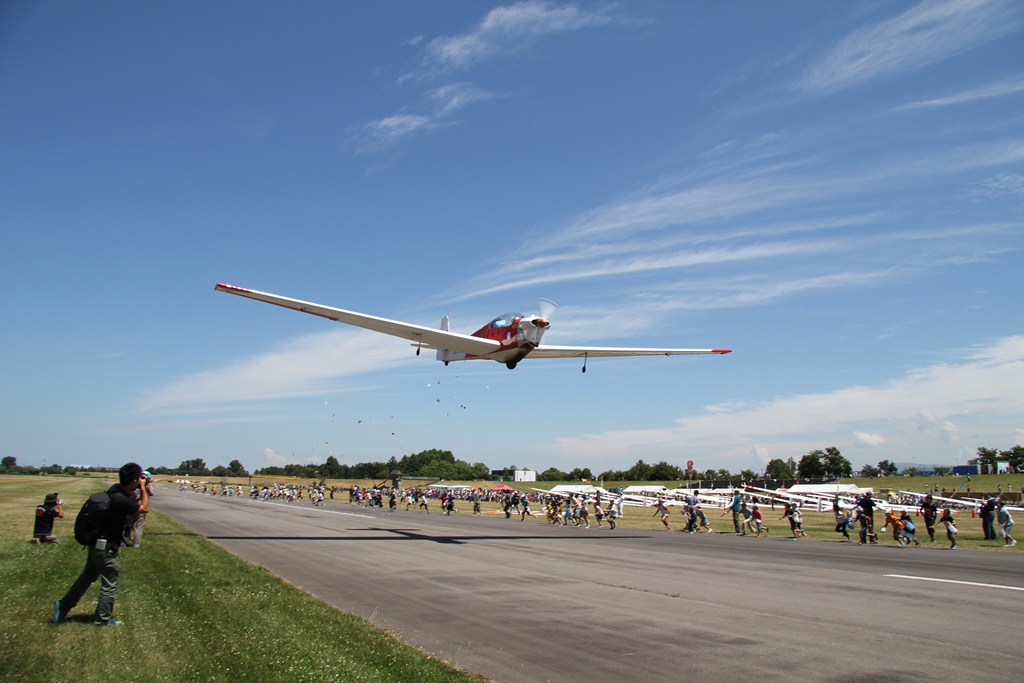
An annual event held on the last Sunday of July, the Summer Sky Festival celebrates sky sports. An airshow, aerobatic flight displays by gliders, motor gliders scattering sweets mid-air…Sights that cannot be seen elsewhere in Japan…There are plenty of exciting programs that allow you to come into close contact with the broad skies! This year, we will also be holding the FAI World Championship for electric model aircraft, and the Hokkaido Sky Sports Fair.
FAI World Championship for electric model aircraft July 19 – 27
Hokkaido Sky Sports Fair in Takikawa July 29
Sorachi Wine X Wine Festa

There are numerous wonderful wineries and vineyards in the administrative district of Sorachi. Amid the rising interest in locally produced wines, even within Hokkaido, Hokkaido-produced wine has begun to be marketed as a must-try for tourists. Within Takikawa, there are highly-reviewed eateries with cuisine that excellently complement these wines. The Sorachi Wine X Wine Festa began in order to disseminate information on Takikawa’s gourmet cuisine and Sorachi’s wines. Here, apart from sampling dishes from Takikawa and Sorachi-produced wines, you can also have a taste of the craft beer produced by Takikawa’s Craft Beer Brewery.
Takikawa Lantern Festival
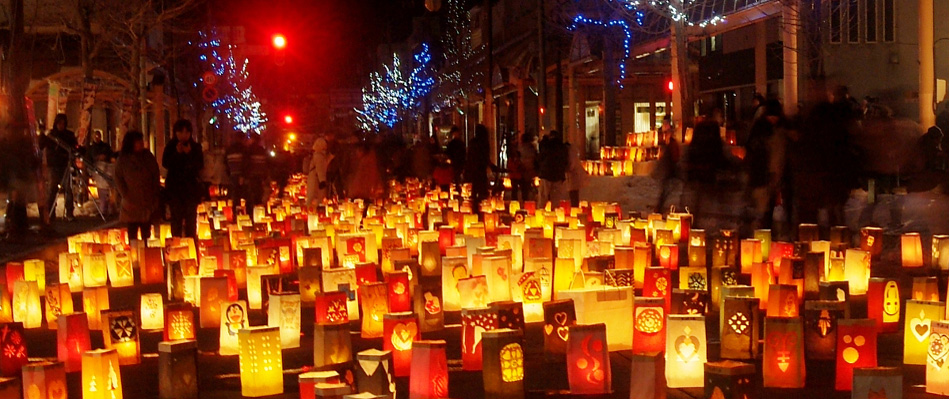
In late February, the Takikawa Lantern Festival lights up the streets for a night with over 10,000 paper lanterns made by the residents of Takikawa.
The event was organized by Igarashi Takenobu, an artist born in Takikawa, with the goal of giving people the joy of crafting their own piece of artwork. It is easy to make a paper lantern and a delightful experience to see your artwork lit up among the many others. All you need is some imagination, a paper bag, and a cutter which is provided for free! So come join us and light up your imagination!
* The date for the festival varies each year. Please check with us for more information.
For more information about tourism in Takikawa
https://www.facebook.com/takikawacity/
Sightseeing Information in the Sorachi Area
Wineries

Hokkaido boasts the largest harvest of grapes for fermentation in Japan.
Yet even within Hokkaido, Sorachi is gathering a lot of attention as a new area for wine production. Some notable examples include the Tsurunuma Winery (which spans a wide area of 447 hectares), Yamazaki Winery (known for its production of high-quality wines in small quantities), and the entry of Bruce Gutlove onto the scene (known for his numerous local and domestic accomplishments as a winemaker). From vineyards built on the sites of former coal mines, to wineries begun by retired individuals, to new producers seeking a challenge, many varieties of wine are being born in Sorachi.
■ Sorachi Winery Book
http://www.sorachi.pref.hokkaido.lg.jp/ss/srk/ttk/winebook.pdf
Sorachi de Cycling

With few cars on the road, we can enjoy cycling at a leisurely pace in the countryside! From the rustic landscapes of rolling fields to challenging mountainous areas for adrenaline lovers eager for serious race courses while touring the area, there are many cycling routes that will allow you to enjoy your fill of Hokkaido. Delight in Sorachi by cycling on routes that bring new surprises every time!
http://www.sorachi.pref.hokkaido.lg.jp/ss/srk/cycling_en.htm
■ Sightseeing in Eastern Sorachi
http://www.ana-exjapan.com/en/feature/beloved-hokkaido/eastern_sorachi.html
Sightseeing Information on Hokkaido
Japan's youngest province, Hokkaido, is the archipelago's northernmost island. Before the 1800s it was inhabited by the Ainu people, a minority group that still exists here and has recently made major breakthroughs in gaining mainstream recognition. Tourists come mainly for the region's outdoor appeal.
For many Japanese, Hokkaido is the last frontier, and this is for good reason. There are more open spaces and national parks here than anywhere else in Japan. While tourism is an important industry, the number of annual visitors is relatively low. Tourists in Hokkaido have the mountains and vistas to themselves.
Sapporo is the most important city on Hokkaido, and it has gone so far as to secure fifth-city status in all of Japan. Even so, the entire Hokkaido region is home to a paltry five percent of the national population, another testament to the remoteness of this island.
In 1972 Hokkaido hosted the Winter Olympics. Since then this has remained a world-class place to ski and snowboard. Two million skiers visit over the course of one season, many of them staying close to Sapporo due to the wealth of local facilities.

Our Recommendation of each area
Douhoku
The northernmost region in Japan, this part of Hokkaido is synonymous with extremes and cold weather. Tourists come for the annual dogsled race in the winter, or for the views of Mt Rishiri, which creates the appearance of a floating mountain out to sea. Finnish reindeer are reared on farms in this part of Hokkaido as well.
Japan's Northern Most Point Monument
The "Japan's Northern Most Point Monument" at Cape Soya stands on the point of latitude 45 degrees 31 minutes. On a sunny day you can see all the way Sakhalin in Russia. This year commemorates the 200th anniversary since the famous explorer Mr. Rinzo Mamiya(left photo) crossed from Wakkanai to Sakhalin, and many events in his memory will take place.

Wakkanai West Coast
Route 106 on the West Coast that takes you all the way to Sarobetsu Moors,(Wakkanai Teshio Sen) is the perfect drive course with not a single telephone pole to get in the way of your view. You can see Mt. Rishiri close by, and in the winter you can also see many harbor seals that come to Bakkai Port.

Doutou
 Still rugged and relatively untouched, Eastern Hokkaido is renown for its virgin forests. Shiretoko Peninsula and the accompanying UNESCO World Heritage site are wildly popular with nature lovers and outdoors types. Japanese cranes are bred here and can be spotted in local marshlands.
Still rugged and relatively untouched, Eastern Hokkaido is renown for its virgin forests. Shiretoko Peninsula and the accompanying UNESCO World Heritage site are wildly popular with nature lovers and outdoors types. Japanese cranes are bred here and can be spotted in local marshlands.
Shiretoko National Park
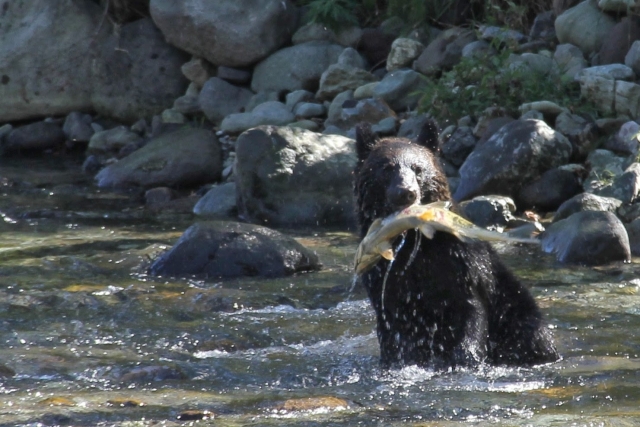
The most celebrated park in Hokkaido, Shiretoko National Park was awarded UNESCO World Heritage status due to its diverse subtropical forests and brown bear population. Visitors must either hike in or arrange transport by boat.
Akan National Park

Together with Daisetsuzan, Akan National Park is the oldest in Japan. It is famous for its hot springs and clear alpine lakes, especially Lake Akan, Lake Kussharo and Lake Mashu. Several high-standing observatories are accessible on foot and offer panoramic views of the countryside.
Taisetsu Mountains
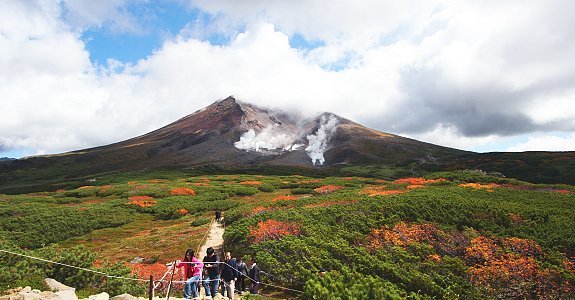
One of the central districts, Taisetsu Tokachi is where tourists can view Hokkaido's renowned lavender fields. The best time to visit is in the early summer when the flowers are in bloom. Other attractions in this part of Hokkaido include Asahiyama Zoo and Lake Shikaribetsu.
Douou

All tourists spend at least a little time in Do-o, the central district, because it includes Sapporo, the most important city on Hokkaido. Much of Hokkaido's infrastructure, from shopping malls to ski resorts, is found here in the center.
There are also a number of institutions celebrating the history and culture of the island.
Dounan
Southern Hokkaido is more temperate than the rest of the island, and this makes it an excellent destination for springtime floral displays. Tourism picks up in this part of the island during the cherry blossom season (April to May), which is also the best time to see Goryokaku Fort with its distinct Western style.
Goryoukaku

Fort Goryokaku is a massive, star shaped, Western style citadel, which was built in the last years of the Edo Period for the defense of Hakodate against the imperialist threat posed by the Western powers. A few years later, the fort became the site of a civil war between an army of the shogunate and the superior troops of the newly established Meiji government.
Oonuma Quasi National Park

Designated as a "quasi national park" and located only twenty kilometers north of Hakodate, Onuma Park is known for its picturesque, island dotted lakes and majestic dormant volcano, Mount Komagatake.
HOKKAIDO OFFICIAL TOURISM WEBSITE
- English http://en.visit-hokkaido.jp/
- 繁體中文 http://tw.visit-hokkaido.jp/
- 简体中文 http://www.visit-hokkaido.org/
- 한국어 http://kr.visit-hokkaido.jp/
Other Informations
The following links contain information on areas we often receive enquiries about at Takikawa Skypark. For more details, please approach staff members at the tourist information center (TIC).
Asahikawa/Biei/Furano Area
Asahiyama Zoo


Asahiyama Zoo is a very popular zoological garden just outside of central Asahikawa City in the middle of Hokkaido. Its popularity lies in the enclosures which allow visitors to observe the animals from various angles, many of which are unique to Asahiyama Zoo.
Highlights include a glass tunnel through the penguin pool that allows visitors to observe the birds' underwater flights, and small glass domes in the middle of the polar bear and wolf enclosures that can get visitors right among the animals. The zoo was also one of the first to organize penguin walks in winter. Work on new enclosures and improvements to existing ones is constantly ongoing.
Animals on display include native wildlife from Hokkaido, including deer, eagles, cranes and (now extinct) wolves, as well as various animals from across the world, such as polar bears, apes, big cats and giraffes. If possible, try to visit the zoo outside of weekends and holidays to reduce the crowds.
Furano Lavender Park

Lavender has been cultivated in Hokkaido for more than half a century. When the arrival of lower priced, imported lavender led to a decrease in demand for Hokkaido's lavender in the 1960s and 70s, the local lavender's main function shifted from agricultural product to tourist attraction.
Nowadays, Furano's lavender fields attract large numbers of visitors to the region every summer, when the plants are in full bloom. The majority of lavender usually starts blooming in late June and reaches its peak from around mid July to early August. Less numerous, later flowering varieties of lavender remain in bloom into mid August.
Many other flowers make Furano an attractive destination outside of the lavender season, as well. The main season for flower viewing takes place between June and September, although some flowers also bloom earlier and later than that. Flowers include rape blossoms, poppies and lupins from June, lilies from July and sunflowers, salvias and cosmos from August and September.
Biei Patchwork fields

Biei is a small town surrounded by a picturesque landscape of gently rolling hills and vast fields. A pleasant way to enjoy the charm of Biei is by cycling or driving through the hills and visiting some of the flower fields and famous trees along the way. The area northwest of the town center is named "Patchwork Road" and the area south of the town center "Panorama Road".
■ Asahikawa
■ Biei
- English https://www.biei-hokkaido.jp/en/
- 繁體中文 https://www.biei-hokkaido.jp/zh_TW/
- 한국어 https://www.biei-hokkaido.jp/ko_KR/
■ Furano
- English http://www.furanotourism.com/en/
- 繁體中文 http://www.furanotourism.com/cn/
- 한국어 http://www.furanotourism.com/kr/
Sapporo/Otaru area
Sapporo
Clock Tower
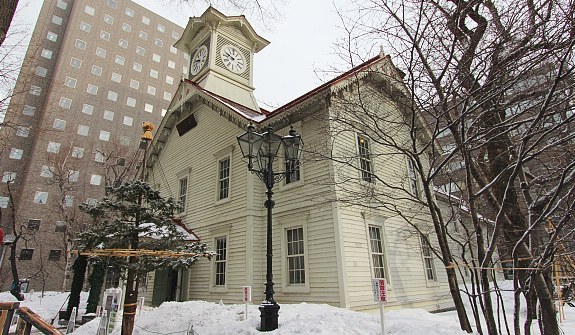
The Clock Tower (Tokeidai) is a symbol of Sapporo. The building was constructed during the early period of Sapporo's development in 1878 as a drill hall of the Sapporo Agricultural College. In 1881 a clock purchased from Boston was installed.
Today, the Clock Tower serves as a museum with displays about the building's history and Sapporo on the first floor. On the second floor are displays about the clock and a spacious ceremony hall that calls to mind the simple buildings of the colonial American Midwest.
Sapporo Ramen
“Sightseeing” and, most of all, “gourmet” are the words that come to mind when you imagine “Hokkaido”! Among all the foods Hokkaido offers, “Sapporo ramen” is extremely popular both in Japan and overseas.

When you ask the Sapporo residents for the best Sapporo ramen restaurants, you will receive various responses.
One characteristic of Sapporo ramen is that each restaurant serves unique and delicious ramen.
Must enjoy them!
Otaru
Canal Area
Otaru Canal (Otaru Unga) was a central part of the city's busy port in the first half of the 20th century. Large vessels were unloaded by smaller ships, which then transported the goods to warehouses along the canal.
The canal became obsolete when modern dock facilities allowed for direct unloading of larger vessels. Thanks to a citizens' movement, a part of the canal was beautifully restored in the 1980s instead of being landfilled, while the warehouses were transformed into, shops and restaurants.
The canal makes for a pleasant stroll during the day, when artists present their works to passing tourists, and during the evenings when old fashioned gas lamps are lit and provide a romantic atmosphere. The canal also serves as the main site of the town's Snow Light Path Festival.
Snow Light Path Festival

The Otaru Snow Light Path Festival (Otaru Yuki Akari no Michi) is a winter festival held every February in Otaru, during which the city becomes decorated in lights and small snow statues for ten days. The festival usually runs at the same time as the nearby Sapporo Snow Festival, making it possible for travelers in Hokkaido to visit both festivals on the same trip.
The combination of the snowy town and the glittering lanterns creates a very pleasant atmosphere. There are two main official festival areas which get lit up daily from 17:00 to 21:00: the Unga Kaijo area and the Temiyasen Kaijo area. In addition, many locals also put lantern displays in front of their shops and residences, which further adds to the festival spirit. The two main areas are both located within a fifteen minute walk of the train station, so travelers can easily enjoy the town's atmosphere on foot.
■ Sapporo http://www.sta.or.jp/english/
■ Otaru
- English http://otaru.gr.jp.e.go.hp.transer.com/
- 繁體中文 http://otaru.gr.jp.t.go.hp.transer.com/
- 简体中文 http://otaru.gr.jp.c.go.hp.transer.com/
- 한국어 http://otaru.gr.jp.k.go.hp.transer.com/
JNTO Tourist Information Center
Asahikawa
■ Asahikawa Tourism & Local Products Information Center
https://tic.jnto.go.jp/detail.php?id=1013
■ Asahikawa Airport Information Center
https://tic.jnto.go.jp/detail.php?id=3223
Furano
■ Furano Biei Tourism Centre
https://tic.jnto.go.jp/detail.php?id=1004
Biei
■ Biei Tourism Association
https://tic.jnto.go.jp/detail.php?id=1711
Sapporo
■ Hokkaido Tourist Information Center Sapporo Tanukikoji(Cat.3)
https://tic.jnto.go.jp/detail.php?id=3056
■ Sapporo Tourist Information center(Cat.3)
https://tic.jnto.go.jp/detail.php?id=3021
Otaru
■ Otaru International Information Center(Canal Plaza Tourist Information) (Cat.2)
https://tic.jnto.go.jp/detail.php?id=1017
- I have lost my way! I have lost my wallet (passport)!
- I am injured. My stomach hurts.
- I would like access to free Wifi.
- I can’t speak Japanese. etc
Traffic Information
Railway (JR Hokkaido Railway)
- English http://www2.jrhokkaido.co.jp/global/index.html
- 繁體中文 http://www2.jrhokkaido.co.jp/global/chinese/index.html
- 简体中文 http://www2.jrhokkaido.co.jp/global/cn/index.html
- 한국어 http://www2.jrhokkaido.co.jp/global/korean/index.html
Road Information(>Northern Road Navi)
- English http://northern-road.jp/navi/eng/index.htm
- 繁體中文 http://northern-road.jp/navi/cht/index.htm
- 简体中文 http://northern-road.jp/navi/chs/index.htm
- 한국어 http://northern-road.jp/navi/kor/index.htm
Airport Information
New Chitose Airport
- English http://www.new-chitose-airport.jp/en/
- 繁體中文 http://www.new-chitose-airport.jp/tw/
- 简体中文 http://www.new-chitose-airport.jp/cn/
- 한국어 http://www.new-chitose-airport.jp/ko/
Asahikawa Airport Passenger Terminal
- English https://www.aapb.co.jp/en/
- 繁體中文 https://www.aapb.co.jp/tw/
- 简体中文 https://www.aapb.co.jp/ch/
- 한국어 https://www.aapb.co.jp/kr/
Ferry Information
Heartland Ferry
- English http://www.heartlandferry.jp/english/
- 简体中文 http://www.heartlandferry.jp/chinese/
- 한국어 http://www.heartlandferry.jp/korean/
Haboro Enkai Ferry
Weather/Disaster Information
■ Safety Tips for Travelers
http://www.jnto.go.jp/safety-tips/eng/index.html
■ The Apps of Safety Tips

■ Guide for when you are feeling ill

